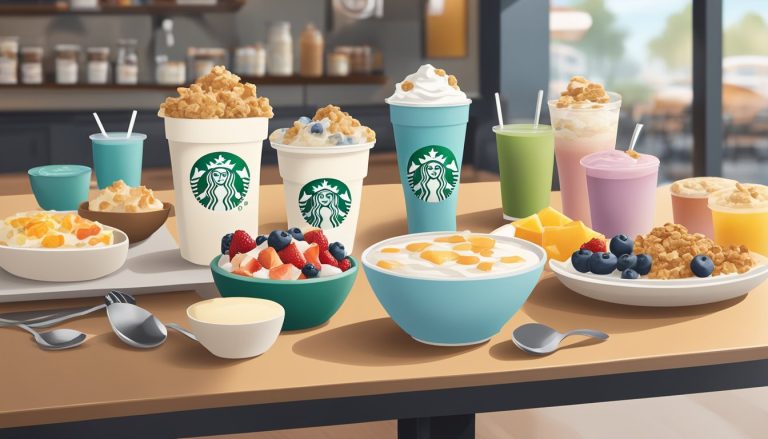Breakfast choices have evolved significantly in recent years, with Starbucks emerging as a popular alternative to traditional morning meals. The global coffee giant has expanded its menu to include a variety of breakfast options, challenging the classic notion of a home-cooked or diner-style breakfast.
Starbucks offers a range of breakfast sandwiches, pastries, and protein boxes that cater to on-the-go consumers, while traditional breakfasts typically feature heartier fare like eggs, bacon, and pancakes. This shift reflects changing lifestyles and preferences, as busy professionals and students seek convenient yet satisfying morning options.
The comparison between Starbucks breakfast and traditional breakfast extends beyond menu items to factors such as nutritional value, cost, and cultural significance. As consumers become more health-conscious and time-pressed, the debate over which breakfast option reigns supreme continues to evolve, shaping the morning routines of millions worldwide.
Background of Breakfast Offerings

The landscape of breakfast offerings has evolved significantly, shaped by changing consumer preferences and the rise of coffee shop culture. Coffee shops and traditional breakfast establishments have developed distinct approaches to morning meals.
Evolution of the Coffee Shop Breakfast
Coffee shops transformed from simple beverage stops to full-fledged breakfast destinations. In the 1990s, pastries and muffins dominated coffee shop menus. As customer demand grew, offerings expanded to include heartier options like sandwiches and wraps.
By the early 2000s, many coffee shops introduced hot breakfast items. Egg sandwiches, oatmeal, and yogurt parfaits became staples. These quick, portable options catered to busy professionals seeking convenience.
Coffee shops also began emphasizing healthier choices. Whole grain breads, fruit cups, and protein boxes gained popularity. This shift reflected growing health consciousness among consumers.
Starbucks’ History in Breakfast Service
Starbucks entered the breakfast market in 1987 with pastries and muffins. The company’s breakfast strategy evolved rapidly in the 2000s. In 2003, Starbucks launched its first breakfast sandwich.
Starbucks expanded its breakfast menu aggressively between 2006 and 2008. New items included oatmeal, protein plates, and additional sandwich varieties. These additions aimed to boost morning sales and compete with fast-food chains.
In recent years, Starbucks has focused on premium breakfast offerings. Sous vide egg bites, introduced in 2017, exemplify this trend. The company also emphasizes customization, allowing customers to modify breakfast items to their liking.
Traditional Breakfast Roots and Practices
Traditional breakfast practices vary widely across cultures. In Western countries, eggs, bacon, toast, and cereal form the core of many breakfast menus. These staples have deep historical roots, with some tracing back centuries.
Diners and family restaurants have long been bastions of traditional breakfast. These establishments often pride themselves on generous portions and made-to-order dishes. Pancakes, waffles, and omelets are common fixtures on their menus.
In recent decades, traditional breakfast venues have adapted to changing tastes. Many now offer healthier options like egg white omelets and whole grain pancakes. Some have also incorporated international flavors, reflecting growing culinary diversity.
Comparative Framework
To effectively analyze Starbucks breakfast offerings against traditional breakfast options, a structured approach is essential. This framework establishes key criteria and common benchmarks for a fair and comprehensive comparison.
Setting the Criteria
The comparative analysis focuses on several crucial factors. Product variety examines the range of breakfast items available. Nutritional value assesses the health aspects of menu options. Convenience evaluates ease of access and quick service. Price point compares the cost of breakfast at Starbucks versus traditional establishments. Quality of ingredients looks at the sourcing and freshness of components used. Customer satisfaction measures overall experience and repeat business potential.
Identifying Common Benchmarks
Common benchmarks allow for a balanced comparison between Starbucks and traditional breakfast providers. Menu diversity is assessed by counting unique breakfast items offered. Nutritional content is compared using calorie counts and macronutrient profiles. Wait times are measured from order placement to food receipt. Average breakfast meal costs are calculated across menu items. Ingredient sourcing practices are evaluated based on company policies and public information. Customer ratings from reputable review sites provide insight into satisfaction levels.
Starbucks Breakfast Analysis
Starbucks has transformed the breakfast landscape with its innovative menu, health-conscious options, efficient service, and competitive pricing. The coffee giant’s approach to the most important meal of the day reflects its commitment to quality, convenience, and customer satisfaction.
Menu Variety and Innovation
Starbucks offers a diverse breakfast menu that caters to various tastes and dietary preferences. The selection includes classic options like egg sandwiches and oatmeal, as well as trendy items such as sous vide egg bites and protein boxes. Seasonal offerings keep the menu fresh and exciting.
Starbucks frequently introduces new items, staying ahead of food trends. For example, their plant-based breakfast sandwich caters to the growing demand for vegetarian and vegan options.
The company’s global presence allows for regional menu adaptations. In China, Starbucks serves congee and moon cakes, while European locations offer local pastries.
Nutritional Considerations
Starbucks provides detailed nutritional information for all menu items, enabling customers to make informed choices. Many breakfast options are designed to be healthier alternatives to traditional fast food.
Whole grain bakery items and fresh fruit cups offer fiber-rich choices. Reduced-fat milk and dairy alternatives are available for customizing beverages.
Some items, like the Double-Smoked Bacon, Cheddar & Egg Sandwich, are higher in calories and sodium. However, Starbucks also offers lower-calorie options such as the Spinach, Feta & Egg White Wrap.
Convenience and Quick Service
Starbucks excels in providing fast, convenient breakfast options for on-the-go customers. The Starbucks Mobile App allows for pre-ordering and quick pickup, reducing wait times significantly.
Drive-thru locations cater to commuters, while in-store digital menu boards streamline the ordering process. Grab-and-go items like yogurt parfaits and fruit cups are strategically placed for easy access.
Starbucks’ efficient barista training ensures quick preparation of both food and beverages. This speed of service is crucial for morning rush hours.
Pricing and Value for Money
Starbucks positions its breakfast offerings as premium products, often priced higher than fast-food competitors. However, the company justifies this through quality ingredients and customization options.
Rewards program members can earn stars on breakfast purchases, enhancing perceived value. Occasional promotions and combo deals provide opportunities for savings.
While some may find Starbucks breakfast prices steep, others appreciate the quality-to-price ratio. The company’s sustainability efforts, such as ethically sourced ingredients, factor into the pricing strategy.
Starbucks’ competitive pricing within the specialty coffee market helps maintain its position as a daily breakfast destination for many customers.
Traditional Breakfast Analysis

Traditional breakfasts vary across cultures but share common themes of hearty, comforting meals to start the day. These time-honored morning rituals reflect local ingredients, customs, and nutritional philosophies.
Cultural Significance
Traditional breakfasts serve as a cultural touchstone, connecting people to their heritage and community. In the UK, a full English breakfast with eggs, bacon, sausages, and baked beans is a beloved institution. Irish breakfasts often include black and white puddings, showcasing regional specialties. These meals foster a sense of identity and continuity.
Many cultures emphasize sharing breakfast as a family, reinforcing social bonds. The act of preparing and enjoying these meals together creates lasting memories and traditions passed down through generations.
Health and Customization
Traditional breakfasts often provide a balanced mix of protein, carbohydrates, and fats. Eggs feature prominently in many cultures, offering high-quality protein. Whole grains like oatmeal or bread provide sustained energy.
These meals allow for personalization based on individual tastes and dietary needs. Vegetarian options like grilled tomatoes or mushrooms can replace meats. Portion sizes can be adjusted for health goals.
Some traditional breakfasts incorporate fermented foods like yogurt or kefir, supporting gut health. Fresh fruits and vegetables add vital nutrients and fiber to the meal.
Price Points and Perceived Value
Home-cooked traditional breakfasts are often more economical than dining out. Buying ingredients in bulk and preparing meals at home can significantly reduce costs. However, the time investment for preparation may be a consideration for busy individuals.
When offered in restaurants, traditional breakfasts are often seen as good value due to generous portions and variety. Many diners appreciate the craftsmanship and attention to detail in well-prepared traditional dishes.
The perceived value extends beyond monetary considerations. The comfort and nostalgia associated with these meals create an emotional connection that enhances their worth to consumers.
Customer Experience Comparison

Starbucks and traditional breakfast establishments offer distinct customer experiences. Key differences emerge in service speed, ambience, and customer retention strategies.
Service Speed and Efficiency
Starbucks excels in quick service, catering to on-the-go customers. Mobile ordering and drive-thru options streamline the process, reducing wait times.
Traditional breakfast spots often prioritize a leisurely pace. Table service allows for personalized attention but may result in longer waits during peak hours.
Starbucks’ efficiency stems from standardized processes and limited customization. Traditional restaurants offer more menu flexibility but may sacrifice speed.
Ambience and Comfort
Starbucks cultivates a modern, consistent atmosphere across locations. Comfortable seating, Wi-Fi, and curated playlists create a “third place” between home and work.
Traditional breakfast venues vary widely in ambience. Family-owned diners often feature homey decor and a community feel. Upscale brunch spots may offer elegant settings.
Starbucks’ spaces encourage both socializing and individual work. Traditional restaurants typically focus on dining experiences, with less emphasis on extended stays.
Loyalty Programs and Customer Retention
Starbucks’ digital loyalty program is a cornerstone of its customer retention strategy. The Starbucks Rewards app offers personalized deals, easy mobile payments, and point accumulation.
Traditional breakfast establishments rarely match this level of digital engagement. Some may use punch cards or email lists, but these lack the sophistication of Starbucks’ system.
Starbucks leverages data from its app to tailor offerings and marketing. This personalization enhances customer loyalty and drives repeat visits.
Industry and Competitive Landscape

Starbucks operates in a highly competitive coffee industry with several key rivals vying for market share. The company has established itself as a dominant force through strategic positioning and brand recognition.
Market Share and Brand Dominance
Starbucks holds a significant portion of the global coffee chain market. As of 2024, the company commands approximately 40% market share in the United States. Its strong brand identity and widespread presence contribute to this dominance.
Globally, Starbucks operates over 35,000 stores across 80 countries. This extensive network allows the company to maintain its leadership position in many key markets.
Brand value plays a crucial role in Starbucks’ success. The company’s logo and name are instantly recognizable worldwide, fostering customer loyalty and attracting new patrons.
Starbucks vs. Key Rivals
Dunkin’ Donuts stands as Starbucks’ primary competitor in the U.S. market. While Dunkin’ focuses on quick service and affordable options, Starbucks emphasizes premium quality and in-store experience.
McCafé, operated by McDonald’s, presents a formidable challenge with its extensive global reach and value-oriented offerings. Peet’s Coffee competes in the premium coffee segment, often appealing to more discerning coffee enthusiasts.
Independent coffee shops collectively form a significant portion of the market. These establishments often differentiate themselves through unique atmospheres and locally-sourced products.
| Competitor | Key Strengths |
|---|---|
| Dunkin’ Donuts | Quick service, affordability |
| McCafé | Global reach, value pricing |
| Peet’s Coffee | Premium quality, coffee expertise |
| Independents | Unique atmosphere, local appeal |
Emerging Trends and Market Adaptations
The coffee industry is witnessing a shift towards sustainability and ethical sourcing. Starbucks has responded by implementing comprehensive sustainability programs and promoting fair trade practices.
Digital innovation is reshaping customer interactions. Starbucks leads with its mobile app, which accounts for a significant portion of U.S. sales. Competitors are racing to develop similar technologies.
Health-conscious consumers are driving demand for alternative milk options and lower-calorie beverages. Starbucks and its rivals continue to expand their menu offerings to cater to these preferences.
Cold brew and nitro coffee have gained popularity. Starbucks has capitalized on this trend by introducing these products across its stores, with competitors following suit.
Strategic Implications for Starbucks

Starbucks’ breakfast strategy intersects with several key aspects of its overall business approach. The company leverages its global presence, ethical sourcing practices, and innovative concepts to strengthen its position in the breakfast market.
Global Expansion and Local Tactics
Starbucks tailors its breakfast offerings to suit local tastes and preferences in different markets. In Japan, the company introduces matcha-infused beverages and incorporates traditional decor, reflecting local tea-drinking customs. This adaptability allows Starbucks to compete effectively with local breakfast providers.
The company uses data-driven insights to inform store layouts and menu customization. By analyzing customer behavior and preferences, Starbucks optimizes its breakfast menu and store design to maximize appeal in each market.
Starbucks’ premium pricing strategy extends to its breakfast items, positioning them as high-quality alternatives to traditional options. This approach helps maintain the brand’s upscale image while competing in the breakfast segment.
Supply Chain and Ethical Sourcing
Starbucks’ commitment to ethical sourcing impacts its breakfast menu. The company prioritizes sustainable and responsibly sourced ingredients for its food items, aligning with consumer values and enhancing brand reputation.
The global supply chain supports consistent quality across markets. Starbucks leverages its network to ensure fresh ingredients are available for breakfast items in all locations, maintaining product standards worldwide.
Ethical sourcing practices extend beyond coffee to other breakfast ingredients. This approach helps Starbucks differentiate its breakfast offerings and appeal to socially conscious consumers.
Innovation and the Starbucks Reserve Roasteries
Starbucks Reserve Roasteries serve as innovation hubs for new breakfast concepts. These locations experiment with unique breakfast items and preparation methods, which may later be introduced to regular stores.
The Roasteries offer premium breakfast experiences, featuring artisanal techniques and high-end ingredients. This strategy allows Starbucks to test consumer reception to upscale breakfast options.
Innovation in breakfast items complements Starbucks’ coffee offerings. The company develops pairings that enhance the overall customer experience, encouraging higher spend and increased visit frequency.
Starbucks uses its Roasteries to showcase breakfast items that align with its premium brand image. This approach helps position the company as a leader in both coffee and breakfast categories.
Conclusion: Synthesizing the Breakfast Battle

Starbucks has transformed the breakfast landscape with its innovative approach. The coffee giant’s focus on premium offerings and a curated customer experience sets it apart from traditional breakfast options.
Starbucks’ brand recognition plays a crucial role in attracting customers. Many choose Starbucks for breakfast due to familiarity and consistency across locations.
The company’s business strategy emphasizes quality and convenience. This approach resonates with busy professionals and younger generations seeking quick, upscale breakfast options.
Profitability remains a key driver for Starbucks’ breakfast menu. Premium pricing on food and beverages contributes significantly to the company’s bottom line.
Traditional breakfast establishments face challenges competing with Starbucks’ model. Some have adapted by improving coffee quality and expanding grab-and-go options.
The breakfast battle continues to evolve. Starbucks’ success has inspired other chains to innovate, leading to increased competition and diverse choices for consumers.
Ultimately, the winner in this breakfast battle may be the customer. The competition has resulted in improved quality, variety, and convenience across the breakfast market.




